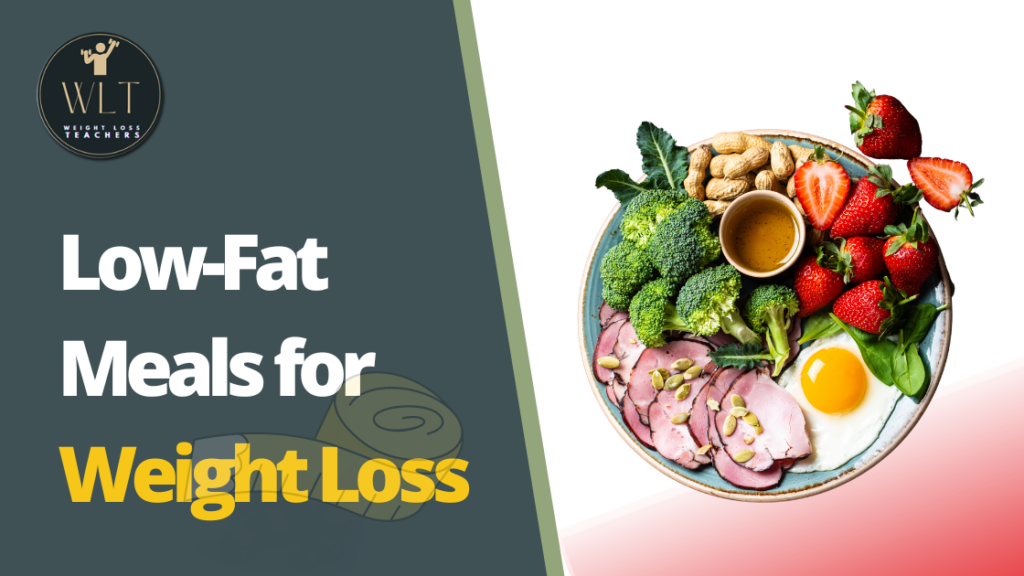
Low-Fat Meals for Weight Loss

In a world where obesity rates continue to rise, weight loss has become a paramount concern for many. There are countless diets and meal plans that promise quick results, but one tried-and-true approach to shedding pounds is through low-fat meals.
Table of Contents
Introduction
Low-fat meals are not only effective for weight loss but also promote overall health and well-being. In this comprehensive guide, we will delve into the world of low-fat meals, exploring their benefits, principles, and providing a plethora of delicious low-fat recipes to help you on your weight loss journey.

Understanding the Basics

2.1 What Are Low-Fat Meals?
Low-fat meals are a dietary approach that prioritizes the reduction of foods rich in saturated and trans fats while emphasizing the inclusion of naturally low-fat options. The primary goal of low-fat meals is to limit the intake of calorie-dense fats while still enjoying a satisfying and nutritionally balanced diet.
These meals revolve around the selection of foods that are naturally low in fat, such as:
- Fruits: Fresh fruits like apples, berries, oranges, and pears are excellent choices. They are not only low in fat but also rich in essential vitamins, minerals, and dietary fiber.
- Vegetables: A wide variety of vegetables, from leafy greens to colorful bell peppers, are naturally low in fat. They provide essential nutrients, antioxidants, and fiber, contributing to overall health.
- Whole Grains: Foods like brown rice, quinoa, whole wheat pasta, and oats are staples in low-fat diets. They offer complex carbohydrates, fiber, and various vitamins and minerals.
- Lean Proteins: Low-fat meals prioritize lean protein sources such as skinless poultry, lean cuts of beef or pork, fish, tofu, and legumes. These options provide essential amino acids without the excess saturated fat found in fatty cuts of meat.
By reducing the consumption of foods high in saturated and trans fats, individuals can lower their overall calorie intake and make healthier choices to support their weight loss goals.
2.2 Why Choose Low-Fat Meals for Weight Loss?
There are compelling reasons to opt for low-fat meals when embarking on a weight loss journey:
- Reduced Caloric Intake: One of the fundamental principles behind low-fat meals is the reduction in caloric intake. Fat is the most calorie-dense macronutrient, containing nine calories per gram, compared to carbohydrates and protein, which both provide only four calories per gram. By minimizing fat consumption, individuals can decrease their overall calorie intake, making it easier to create a calorie deficit necessary for weight loss.
- Heart Health: Low-fat diets have been associated with a lower risk of heart disease and related cardiovascular issues. High intake of saturated and trans fats is linked to elevated levels of LDL (low-density lipoprotein) cholesterol, which can lead to the development of atherosclerosis and an increased risk of heart attacks and strokes. By choosing low-fat meals, individuals can support their heart health and reduce these risks.
- Balanced Nutrition: Low-fat meals encourage the consumption of nutrient-dense foods. Fruits, vegetables, whole grains, lean proteins, and legumes are not only low in fat but also rich in essential vitamins, minerals, fiber, and antioxidants. This balanced nutrition not only supports weight loss but also provides the body with the necessary nutrients for overall health and well-being.
- Sustainable Weight Loss: Low-fat diets are often more sustainable over the long term compared to extreme or restrictive diets. By focusing on whole, satisfying foods and allowing for occasional treats, individuals are more likely to adhere to their dietary plan and maintain their weight loss achievements over time. This sustainability is key to preventing the cycle of yo-yo dieting and promoting a healthy lifestyle.
Building a Low-Fat Diet Plan

3.1 The Principles of a Low-Fat Diet
To construct an effective low-fat diet plan for weight loss, it’s essential to grasp the fundamental principles that underlie this approach. These principles are the building blocks for a healthy and sustainable low-fat eating regimen:
- Choose Lean Protein Sources: When aiming for a low-fat diet, opt for lean protein sources to reduce saturated fat intake. Lean meats like skinless poultry, turkey, and cuts of beef or pork labeled as “loin” or “round” are excellent choices. Additionally, seafood like fish and shellfish, tofu, tempeh, and legumes such as lentils, chickpeas, and black beans are rich in protein while being low in unhealthy fats.
- Incorporate Whole Grains: Whole grains are a vital component of a low-fat diet. Options like brown rice, quinoa, whole wheat pasta, whole grain bread, and oats provide essential nutrients, including fiber, vitamins, and minerals. Their high fiber content promotes satiety, aiding in weight loss, and stabilizes blood sugar levels.
- Load Up on Fruits and Vegetables: Fruits and vegetables should be the cornerstone of your low-fat meal plan. These foods are not only naturally low in fat but also abundant in vitamins, minerals, antioxidants, and dietary fiber. Incorporating a colorful array of fruits and vegetables into your meals supports weight loss efforts and contributes to overall health. Aim to fill half your plate with vegetables and fruits at every meal.
- Use Healthy Cooking Methods: How you prepare your meals can significantly impact their fat content. Choose cooking methods that use minimal oil or healthy fats like olive oil. Methods such as steaming, baking, grilling, or sautéing with limited oil can help keep fat content low while preserving flavor and nutrition.
- Be Mindful of Hidden Fats: Even on a low-fat diet, it’s crucial to be vigilant about hidden fats in processed foods, salad dressings, and sauces. Read food labels carefully to identify added fats and choose low-fat or fat-free options when available. Homemade sauces and dressings made with healthier ingredients can be excellent alternatives.
- Control Portion Sizes: While low-fat foods are generally lower in calories than their high-fat counterparts, portion control remains crucial. Overeating even low-fat foods can lead to an excess of calories and hinder weight loss efforts. Utilize measuring cups, portion guidelines, and mindful eating practices to avoid unintentionally consuming too many calories.
3.2 Designing a Low-Fat Meal Plan
Designing a personalized low-fat meal plan tailored to your specific needs involves careful planning and consideration. Here are some tips and guidelines for creating a balanced and sustainable low-fat meal plan:
- Set Realistic Goals: Determine your weight loss goals and create a meal plan that aligns with them. Be realistic about the number of calories you need to consume and how much weight you want to lose.
- Plan Balanced Meals: Ensure that each meal contains a balance of lean protein, whole grains, and plenty of fruits and vegetables. This combination provides essential nutrients while keeping fat intake in check.
- Variety is Key: Incorporate a variety of foods to prevent mealtime boredom and ensure you receive a wide range of nutrients. Experiment with different vegetables, grains, and protein sources to keep your taste buds engaged.
- Meal Prep: Consider meal prepping to make sticking to your low-fat meal plan more manageable. Prepare components of your meals in advance, such as chopping vegetables, cooking grains, or marinating proteins. This can save time and reduce the temptation to opt for less healthy options when you’re in a hurry.
- Snack Smart: Choose low-fat, high-fiber snacks to keep hunger at bay between meals. Options like fresh fruit, yogurt, air-popped popcorn, and raw vegetables with hummus are excellent choices.
- Stay Hydrated: Drinking plenty of water throughout the day can help control appetite and support overall health. Sometimes, thirst can be mistaken for hunger.
- Monitor Progress: Keep a food diary to track your meals, portion sizes, and any noticeable changes in your weight and health. This can help you identify what’s working and make necessary adjustments to your meal plan.
The Benefits of Low-Fat Meals

4.1 Weight Loss and Weight Maintenance
Low-fat meals have long been recognized as an effective strategy for weight loss and maintaining a healthy weight over the long term. The fundamental principle behind this benefit is the reduction of calorie-dense fats in the diet.
When individuals consume fewer calories than they expend, they create a calorie deficit, which is essential for weight loss. Fats are the most calorie-dense macronutrient, containing nine calories per gram, while carbohydrates and proteins provide only four calories per gram. By reducing fat intake, individuals can naturally lower their overall calorie consumption.
Low-fat meals promote weight loss in several ways:
- Reduced Caloric Intake: By choosing foods that are naturally low in fat, individuals can enjoy satisfying meals with fewer calories. For instance, a salad with lean protein and a vinaigrette dressing contains fewer calories than a high-fat, creamy salad.
- Increased Satiety: High-fiber foods, such as fruits, vegetables, and whole grains, which are commonly found in low-fat meals, help individuals feel full and satisfied. This satiety factor can lead to reduced overall food intake, supporting weight loss efforts.
- Improved Food Choices: Low-fat meal planning encourages the selection of nutrient-dense foods, promoting healthier eating habits. Instead of opting for high-fat, empty-calorie foods, individuals are more likely to choose foods that provide essential nutrients while keeping calories in check.
- Sustainability: Low-fat diets are often more sustainable over time compared to extreme or restrictive diets. They allow for a variety of foods and flavors, reducing the likelihood of feeling deprived or falling off the diet, which can occur with overly restrictive plans.
4.2 Heart Health
A significant benefit of low-fat meals is their positive impact on heart health. Heart disease is a leading cause of mortality worldwide, making dietary choices that support cardiovascular well-being crucial.
Low-fat diets are associated with several heart-healthy benefits:
- Lower LDL Cholesterol: Low-density lipoprotein (LDL) cholesterol, often referred to as “bad” cholesterol, can contribute to the buildup of plaque in arteries, leading to atherosclerosis and an increased risk of heart attacks and strokes. Low-fat diets, especially those emphasizing the reduction of saturated and trans fats, help lower LDL cholesterol levels, reducing the risk of these cardiovascular events.
- Reduced Risk of Atherosclerosis: Atherosclerosis is the narrowing and hardening of arteries due to plaque buildup. By reducing dietary fat intake, particularly saturated and trans fats, individuals can slow down or even reverse this process, improving blood flow and reducing the risk of heart disease.
- Heart Disease Prevention: Low-fat meals contribute to an overall reduction in the risk of heart disease. Consistent adherence to a low-fat diet, combined with other heart-healthy lifestyle choices like regular physical activity and smoking cessation, can significantly decrease the likelihood of heart-related issues.
4.3 Diabetes Management
Low-fat meals can be especially beneficial for individuals with diabetes or those at risk of developing the condition. Diabetes is a metabolic disorder characterized by impaired blood sugar regulation, and diet plays a critical role in its management.
Low-fat diets offer several advantages for diabetes management:
- Blood Sugar Control: Low-fat meals help stabilize blood sugar levels, preventing rapid spikes and crashes in glucose. This can be particularly beneficial for individuals with type 2 diabetes or those at risk of developing the condition.
- Reduced Risk of Complications: Diabetes is associated with an increased risk of heart disease, nerve damage, and other complications. Low-fat diets, which support heart health and weight management, can help reduce these risks and improve overall well-being.
- Weight Management: Many individuals with diabetes struggle with weight management. Low-fat meals can aid in weight loss and maintenance, which is crucial for diabetes management. Maintaining a healthy weight can improve insulin sensitivity and blood sugar control.
4.4 Improved Digestion
The high fiber content in many low-fat foods, such as fruits, vegetables, and whole grains, is instrumental in promoting healthy digestion. Fiber is essential for various aspects of digestive health:
- Regular Bowel Movements: Adequate fiber intake helps prevent constipation and promotes regular and comfortable bowel movements. This is particularly beneficial for those who may struggle with digestive issues.
- Healthy Gut Microbiome: Fiber serves as a prebiotic, providing nourishment for beneficial gut bacteria. A thriving gut microbiome is linked to improved digestion, enhanced nutrient absorption, and even immune system support.
- Satiety: Fiber-rich foods help individuals feel full and satisfied, reducing the likelihood of overeating and aiding in portion control.
4.5 Enhanced Energy Levels
Low-fat meals can provide a steady and sustained source of energy throughout the day. This is in contrast to high-fat, high-sugar diets, which can lead to energy crashes and feelings of fatigue.
The benefits of low-fat meals for energy levels include:
- Steady Blood Sugar: Low-fat meals help maintain stable blood sugar levels, preventing the rapid spikes and crashes associated with high-sugar diets. This steadiness in blood sugar contributes to sustained energy throughout the day.
- Reduced Fatigue: A diet low in fat and high in nutrient-dense foods provides the body with the necessary nutrients for optimal energy production. This can lead to increased vitality, alertness, and productivity.
- Improved Physical Performance: Low-fat diets can support physical activity and exercise performance by providing the necessary carbohydrates for energy and protein for muscle repair and growth.
Challenges and Common Misconceptions

5.1 Overemphasizing Low-Fat Processed Foods
One common challenge and misconception associated with low-fat diets are the overemphasis on low-fat processed foods. Many people assume that if a product is labeled as “low-fat,” it must be a healthy choice. However, this assumption can be misleading.
Some low-fat processed foods compensate for the reduced fat content by adding sugars, artificial flavorings, and other unhealthy additives. This can lead to several problems:
- Hidden Sugars: To enhance taste and palatability, manufacturers often add sugars to low-fat products. Excess sugar consumption can contribute to weight gain, blood sugar spikes, and an increased risk of metabolic issues like type 2 diabetes.
- Reduced Nutrient Density: Low-fat processed foods may lack essential nutrients found in whole, unprocessed foods. By choosing these products, individuals miss out on vitamins, minerals, and dietary fiber that are crucial for overall health.
- Less Satiety: Low-fat processed foods are sometimes less satisfying than their full-fat counterparts due to the lack of fat, which contributes to a sense of fullness and satiety. As a result, individuals may end up consuming more calories to feel satisfied, negating the intended benefits of a low-fat diet.
To navigate this challenge, it’s crucial to read food labels carefully. Look beyond just the “low-fat” claim and check for added sugars, artificial additives, and overall nutritional value. In general, it’s advisable to choose whole, natural foods whenever possible. Focus on incorporating fresh fruits, vegetables, lean proteins, and whole grains into your diet while minimizing reliance on heavily processed low-fat products.
5.2 Fear of All Fats
Another common misconception surrounding low-fat diets is the fear of all fats, including healthy ones. While it’s essential to reduce saturated and trans fats, it’s equally important to recognize that not all fats are detrimental to health. In fact, healthy fats play crucial roles in overall well-being.
Healthy fats, such as those found in avocados, nuts, seeds, and fatty fish like salmon and mackerel, offer several benefits:
- Heart Health: Omega-3 fatty acids, abundant in fatty fish, have been linked to a reduced risk of heart disease. They help lower blood pressure, reduce inflammation, and improve cholesterol levels.
- Brain Health: Healthy fats are essential for brain function. They support cognitive function, memory, and mood regulation.
- Nutrient Absorption: Certain fat-soluble vitamins (A, D, E, and K) require dietary fat for absorption. Incorporating healthy fats into your diet ensures your body can efficiently use these essential vitamins.
- Satiety: Fats contribute to a sense of fullness and satisfaction after a meal, helping control appetite and prevent overeating.
To address the fear of all fats, it’s essential to strike a balance in your diet. Rather than eliminating all fats, aim for moderation and prioritize healthy fats. Incorporate sources like avocados, nuts, and olive oil into your meals. Remember that healthy fats should complement a low-fat diet, not replace it entirely.
5.3 The Importance of Balance
A common challenge with low-fat diets is the tendency to lean towards extreme restriction, eliminating all fats from the diet. However, this approach is neither sustainable nor healthy in the long run. It’s vital to emphasize balance in your dietary choices.
Balance in a low-fat diet plan means:
- Moderation: Include healthy fats in your diet in moderation. Rather than avoiding them entirely, consume them in appropriate portions.
- Whole, Nutrient-Dense Foods: Prioritize whole, nutrient-dense foods such as fruits, vegetables, lean proteins, and whole grains. These foods provide essential nutrients and fiber while keeping overall calorie and fat intake in check.
- Mindful Eating: Pay attention to portion sizes and practice mindful eating. Be aware of your body’s hunger and fullness cues to avoid overeating.
- Variety: Incorporate a variety of foods into your diet to ensure you receive a wide range of nutrients and flavors. This also helps prevent dietary boredom.
- Long-Term Sustainability: Focus on creating a dietary plan that you can maintain over the long term. Extreme restrictions or deprivation are often unsustainable and can lead to frustration and eventual abandonment of the diet.
Note: There might be affiliate links mentioned here. We may receive a commission if you purchase a product through an affiliate link. There is no additional charge for you. Please do your own research before making any online purchases.
Low-Fat Recipes for Weight Loss

- Grilled Chicken Salad
Grilled chicken salad is a classic dish that is perfect for weight loss. It is low in calories and fat, yet it is packed with protein and nutrients. To make this dish, start by grilling a chicken breast until it is fully cooked. Next, chop up some lettuce, tomatoes, and cucumbers and add them to a bowl. Add the grilled chicken on top and drizzle with a low-fat dressing of your choice. This dish is perfect for lunch or dinner.
- Baked Salmon
Salmon is a great source of omega-3 fatty acids and is low in calories and fat. To make baked salmon, start by preheating your oven to 350 degrees Fahrenheit. Season the salmon fillet with salt, pepper, and herbs of your choice. Bake the salmon for 15-20 minutes, or until it is fully cooked. Serve with a side of vegetables for a healthy and nutritious meal.
- Vegetable Stir-Fry
Vegetable stir-fry is a great low-fat meal that is packed with nutrients. To make this dish, start by chopping up some vegetables of your choice, such as broccoli, carrots, bell peppers, and onions. Heat up some oil in a wok or a large frying pan and add the vegetables. Stir-fry for a few minutes until the vegetables are cooked but still crunchy. Serve with a side of brown rice for a complete meal.
- Turkey Chili
Turkey chili is a delicious and healthy meal that is perfect for weight loss. To make this dish, start by browning some ground turkey in a large pot. Add some diced onions, garlic, and bell peppers and sauté until the vegetables are soft. Add some canned tomatoes, kidney beans, and chili powder and let simmer for 30 minutes. Serve with a side of low-fat sour cream and shredded cheese.
- Sweet Potato and Black Bean Burrito
Sweet potato and black bean burrito is a tasty and nutritious meal that is perfect for lunch or dinner. To make this dish, start by baking a sweet potato until it is fully cooked. Mash the sweet potato and mix it with some black beans, diced tomatoes, and chili powder. Spoon the mixture onto a whole wheat tortilla and roll it up. Serve with a side of salsa and low-fat sour cream.
- Broiled Cod
Broiled cod is a simple and healthy meal that is perfect for weight loss. To make this dish, start by preheating your broiler. Season the cod fillet with salt, pepper, and herbs of your choice. Broil the cod for 10-15 minutes, or until it is fully cooked. Serve with a side of steamed vegetables for a complete meal.
- Quinoa Salad
Quinoa salad is a nutritious and delicious meal that is perfect for weight loss. To make this dish, start by cooking some quinoa according to the package instructions. Add some chopped vegetables of your choice, such as cucumber, bell pepper, and cherry tomatoes. Mix in some low-fat dressing and serve chilled.
- Chicken Fajitas
Chicken fajitas are a delicious and healthy meal that is perfect for weight loss. To make this dish, start by marinating some chicken breast in a mixture of lime juice, chili powder, cumin, and garlic. Grill the chicken until it is fully cooked. Add some sliced onions and bell peppers to the same grill and cook until they are soft and slightly charred. Serve the chicken and vegetables on a whole wheat tortilla with some low-fat sour cream and salsa.
- Lentil Soup
Lentil soup is a healthy and filling meal that is perfect for weight loss. To make this dish, start by sautéing some diced onions and garlic in a large pot. Add some chopped carrots, celery, and potatoes and sauté for a few minutes. Add some lentils and vegetable broth and let simmer for 30 minutes. Serve with a side of whole grain bread for a complete meal.
- Tuna Salad
Tuna salad is a simple and healthy meal that is perfect for lunch or dinner. To make this dish, start by draining a can of tuna and mixing it with some chopped celery, red onion, and low-fat mayonnaise. Serve on a bed of lettuce or on a whole wheat bread for a filling and satisfying meal.
Tips for Success on a Low-Fat Diet

Embarking on a low-fat diet for weight loss can be a rewarding journey towards improved health and well-being. However, success in achieving your weight loss goals and maintaining them over the long term often requires careful planning, commitment, and a few helpful strategies. Here are some essential tips to guide you on your path to success:
7.1 Keep a Food Journal to Track Your Intake:
One of the most effective tools for staying on track with your low-fat diet is keeping a food journal. This simple yet powerful practice involves recording everything you eat and drink throughout the day. By documenting your meals and snacks, you gain insight into your eating habits and can identify areas for improvement.
In your food journal, make note of the following:
- The foods and beverages you consume.
- Portion sizes and quantities.
- The time of day you eat.
- Any emotional or situational triggers for eating (e.g., stress, boredom, social occasions).
Keeping a food journal can help you become more mindful of your dietary choices, pinpoint patterns of overeating or unhealthy eating, and make necessary adjustments to stay within your low-fat guidelines. It also provides accountability and allows you to track your progress over time.
7.2 Plan Meals and Snacks in Advance:
Successful adherence to a low-fat diet often requires careful meal planning. Preparing meals and snacks in advance ensures that you have nutritious and low-fat options readily available, reducing the temptation to opt for less healthy choices when you’re hungry and in a rush.
Consider the following meal planning strategies:
- Create a weekly meal plan that outlines breakfast, lunch, dinner, and snacks.
- Make a shopping list based on your meal plan to ensure you have the necessary ingredients on hand.
- Prepare and portion meals and snacks ahead of time, especially for busy days.
- Include a variety of low-fat foods and recipes to keep your meals interesting and satisfying.
Meal planning not only supports your low-fat diet but also helps you make informed choices, save time, and reduce food waste. It allows you to focus on nutrient-dense options while minimizing unhealthy temptations.
7.3 Stay Hydrated with Water or Herbal Tea:
Proper hydration is crucial for overall health and can be particularly beneficial when following a low-fat diet. Water helps control appetite, supports metabolism, and aids in digestion. When you’re well-hydrated, you’re less likely to mistake thirst for hunger, reducing the temptation to overeat.
To stay hydrated:
- Aim to drink at least 8 cups (64 ounces) of water daily, adjusting for your individual needs and activity level.
- Consider incorporating herbal teas or infusions without added sugars as a flavorful and hydrating option.
- Carry a reusable water bottle to remind yourself to drink throughout the day.
Hydrating adequately not only supports your weight loss efforts but also promotes overall well-being.
7.4 Get Regular Exercise to Complement Your Diet:
While a low-fat diet is a valuable component of weight loss, incorporating regular exercise is equally important. Physical activity helps burn calories, build lean muscle, improve cardiovascular health, and enhance your overall fitness level.
To complement your low-fat diet:
- Engage in a combination of aerobic exercises (e.g., walking, jogging, cycling) and strength training to maximize calorie expenditure and muscle development.
- Aim for at least 150 minutes of moderate-intensity aerobic activity or 75 minutes of vigorous-intensity aerobic activity per week, as recommended by health guidelines.
- Find physical activities you enjoy to make exercise a sustainable part of your routine.
Exercise not only enhances your weight loss efforts but also boosts your energy levels, mood, and overall health.
7.5 Seek Support from Friends, Family, or a Dietitian:
Last but not least, seeking support can be a valuable factor in your success on a low-fat diet. Sharing your goals and progress with friends, family members, or a registered dietitian can provide motivation, encouragement, and accountability.
Consider these support strategies:
- Share your dietary goals and meal plans with a friend or family member who can offer encouragement and participate in healthy activities with you.
- Connect with a registered dietitian or nutritionist who can provide personalized guidance, answer questions, and help you tailor your low-fat diet to your specific needs.
Having a support system in place can make your weight loss journey more enjoyable and successful. It can also provide valuable insights and resources to help you navigate any challenges you may encounter along the way.
FAQs (Frequently Asked Questions)
Q1: What are low-fat meals, and why are they recommended for weight loss?
A1: Low-fat meals are a dietary approach that focuses on reducing the consumption of calorie-dense fats while prioritizing foods naturally low in fat, such as fruits, vegetables, lean proteins, and whole grains. They are recommended for weight loss because they help create a calorie deficit by reducing overall calorie intake. Fats are calorie-dense, and by minimizing their consumption, individuals can achieve their weight loss goals more effectively.
Q2: Can I still enjoy satisfying meals on a low-fat diet?
A2: Absolutely! Low-fat meals can be both delicious and satisfying. By incorporating lean proteins, whole grains, and a variety of fruits and vegetables, you can create flavorful and filling dishes. Additionally, using herbs, spices, and low-fat cooking methods can enhance the taste of your meals.
Q3: What are the health benefits of low-fat meals, beyond weight loss?
A3: Low-fat meals offer several health benefits, including improved heart health by reducing LDL cholesterol, support for diabetes management by stabilizing blood sugar levels, enhanced digestion due to their high fiber content, and sustained energy levels throughout the day.
Q4: Are all fats bad for you?
A4: No, not all fats are bad. Healthy fats, such as those found in avocados, nuts, seeds, and fatty fish, have numerous health benefits. These fats are essential for various bodily functions, including heart and brain health. A balanced diet should include these healthy fats in moderation while minimizing saturated and trans fats.
Q5: How can I avoid overemphasizing low-fat processed foods on a low-fat diet?
A5: To avoid overemphasizing low-fat processed foods, read food labels carefully to identify added sugars and unhealthy additives. Focus on whole, natural foods like fruits, vegetables, lean proteins, and whole grains. Limit reliance on heavily processed low-fat products and prioritize homemade meals.
Q6: Is it necessary to eliminate all fats from my diet to succeed on a low-fat diet?
A6: No, it’s not necessary to eliminate all fats. In fact, it’s essential to strike a balance by incorporating healthy fats into your diet. Healthy fats, like those found in avocados and nuts, offer various health benefits and should complement your low-fat meal plan.
Q7: How can I create a balanced low-fat meal plan that I can maintain over the long term?
A7: To create a balanced low-fat meal plan, focus on moderation, whole nutrient-dense foods, mindful eating, variety, and long-term sustainability. Include lean proteins, whole grains, and plenty of fruits and vegetables. Pay attention to portion sizes and set realistic goals to make your diet plan sustainable.
Q8: What is the role of exercise in complementing a low-fat diet for weight loss?
A8: Exercise is essential in complementing a low-fat diet for weight loss. It helps burn calories, build lean muscle, improve cardiovascular health, and boost overall fitness. Regular physical activity enhances your weight loss efforts and contributes to better health.
Q9: How can I stay motivated and accountable on a low-fat diet?
A9: Staying motivated and accountable on a low-fat diet can be achieved by keeping a food journal to track your intake, planning meals and snacks in advance, staying hydrated, engaging in regular exercise, and seeking support from friends, family, or a registered dietitian. These strategies provide motivation, structure, and encouragement on your weight loss journey.
Q10: Can I still enjoy flavorful meals on a low-fat diet?
A10: Yes, you can enjoy flavorful meals on a low-fat diet by using herbs, spices, and low-fat cooking methods like grilling, baking, or sautéing. Experiment with different seasonings and ingredients to create satisfying and tasty dishes that align with your dietary goals.
Conclusion
Low-fat meals offer a practical and sustainable approach to weight loss and improved overall health. By embracing a balanced low-fat diet plan, incorporating nutrient-dense foods, and following the principles outlined in this guide, you can achieve your weight loss goals and enjoy the many health benefits that come with it. Remember that long-term success comes from making healthy eating a lifestyle choice rather than a temporary fix. So, start your journey towards a healthier you today with delicious, satisfying low-fat meals.






